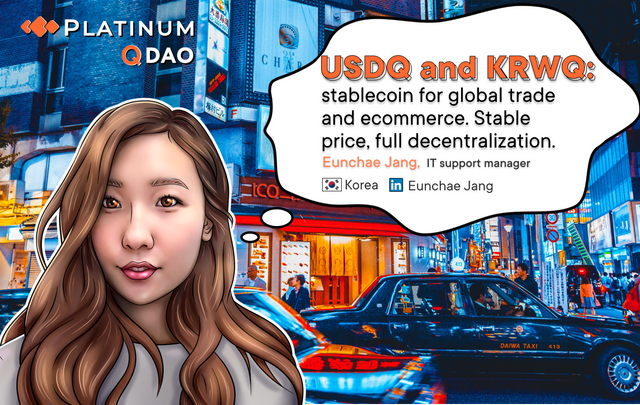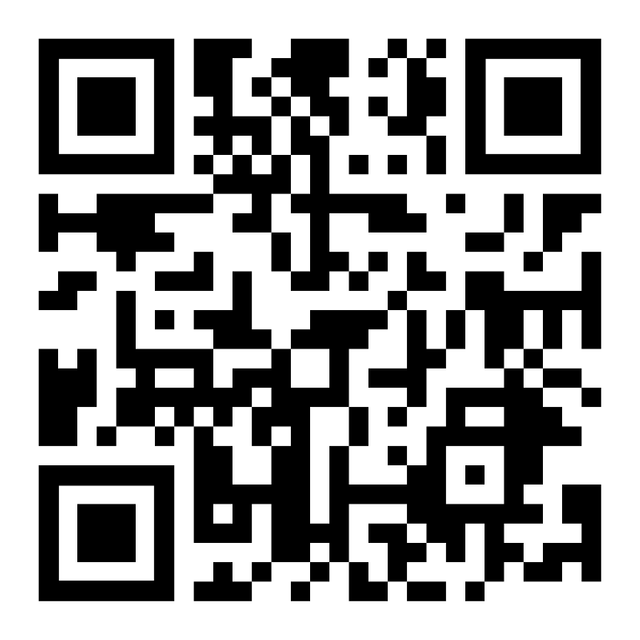How do real stablecoins USDQ and KRWQ work? An Ultimate Guide from Platinum Q DAO

Eunchae Jang has extensive experience in IT support roles. She currently works as an IT Support Manager at Platinum Q DAO Engineering, enabling the development of USDQ, KWRQ, JPYQ, SGDQ, HKDQ, and CNYQ a fully decentralized stablecoins for Bitcoin collateralization, under Q DAO brand.
For the past 3 years, Platinum Company became the biggest Listing Broker in the world: we have listed 300+ projects on Top Exchanges and supported Market Making for 70+ projects.
Platinum STO/ICO fundraising dashboard and tokenization platform are now installed to 30+ projects, and it has helped them to raise more $350,000,000
In Platinum Q DAO Engineering we are creating a lot of cool stuff:
BTCNEXT — most secured, compliance and regulated Exchange. built by Traders for Traders
Decentralized Stablecoins KRWQ, USDQ, JPYQ, CNYW (we are second Stablecoins DAO after Maker DAO)
Today I will tell you about the Q DAO ecosystem in depth.
Similar to many other successful projects, USDQ/KRWQ leverages a stack of highly complex technologies and concepts, which require an in-depth review. Moreover, KRWQ — a stablecoin pegged to Korean Won will be attached to Q DAO family. This will not only make a huge impact on the local Korean market but also to the whole Asian region
Q DAO is a classic utility coin, but it has very important governance features. In order to understand how it works, it’s best to first grasp the interrelation between the two coins, operating within the ecosystem — USDQ/KRWQ and Q DAO.
How do stablecoins work?
In the nutshell, stablecoin’s value is pegged to the value of another asset.
With regard to this ecosystem, it includes a coin named USDQ or KRWQ. It’s pegged to 1USD in the soft format, i.e. its price can sometimes a little deviate from 1 USD, but it ALWAYS returns to this level. Most of the other stablecoins don’t effectively institute the pegs, but they can be seen as just an “avatar” for fiat currency. The managing company takes fiat from users and transfers to them a coin, which in fact is a form of a “promissory note”, quite similar to how fiats work.
As a result, such systems need to have a central point of control — a company which receives the fiat and provides the stablecoins in return. Such a centralized approach goes against the very philosophy, based on which the crypto industry has been built.
In contrast, the USDQ/KRWQ system does not use any fiat as a collateral. Instead, USDQ acts as a stablecoin, while the internal governance token Q DAO is allowed to remain freely floating and volatile.
Why do we need stablecoins anyway?
Newcomers might have a problem with seeing how stablecoins bring value and why the crypto community needs them at all. But if you take a deeper dive, you’ll see why enthusiasts talk so much about them.
To better understand the stablecoins, let’s first analyze Bitcoin, serving as a perfect example of a classic cryptocurrency:
In spite of Bitcoin becoming so popular and many people thinking about it as a cardinally new form of money, it’s virtually impossible to use it for the original purpose. Purchasing things with Bitcoin makes very little sense. With extremely huge price growth in the past, nobody would want to spend Bitcoin on buying some things and missing out on the next big move.
In addition, financial companies can’t use Bitcoin to offer standard financial services to the general population, such as deposits, lending and others. The point is that with high volatility, they won’t be able to manage interest rates because Bitcoin can skyrocket by dozens of percentage points at any point in time.
And this is the perfect opening for stablecoins to bring out their value. Coins like USDQ/KRWQ will become (I hope) the trigger, required to push mass adoption and maybe even replace fiats in the years to come.
How is USDQ generated?
USDQ is created by a smart contract. The system accepts Bitcoin as a collateral and outputs the stablecoin in exchange. Other top 10 cryptocurrencies are planning to be implemented as a collateral in the future.
The procedure used is similar to obtaining a mortgage loan from a bank. Quite common practice, when a bank would provide a loan amount, equal to a maximum 70% of the net value of your collateral. In this way, the bank protects itself against a potential depreciation in the asset’s value.
The USDQ ecosystem operates in a similar manner. Whenever a user wishes to obtain a loan, they will be asked to collateralize an amount in Bitcoin that is higher than the loan’s value. As of now, this rate stands at 166%.
How are Q DAO Tokens used?
Q DAO ecosystem is a decentralized autonomous organization, in which USDQ and Q DAO tokens circulate, enabled by underlying smart contracts and blockchain solutions. This system is a great example of the power that blockchains bring to the wider economy and finance. Smart contracts, used to execute transactions, eliminate the need in the third party, while also helping cut costs and increase processing speed. In the nutshell, all of the mechanisms used within the system are focused on mitigating potential volatility of USDQ against its peg, USD.
If you decide to exchange USDQ back into Bitcoins, the smart contract will automatically return you the amount in Bitcoins and destroy the respective amount of USDQ.
What are the use cases for Q DAO, the internal governance token?
Q DAO has three main use cases — acting as a utility token, enabling system governance and sustaining recapitalization mechanisms.
As a utility token, Q DAO is used to pay out fees, charged upon USDQ generation via CDCs. Thus, whenever a user pays out fees in Q DAO, this amount is received by the system and then automatically destroyed.
With this destruction process being performed consistently, the number of Q DAO units decreases and thus — due to reducing supply — the prices grow.
As a governance token, Q DAO is used to enable community members to participate in the votes. Importantly, within the USDQ system, all decisions are put on the ballot with Q DAO voters being able to vote against proposals, required for any changes within the system.
The community has votes on a regular basis, which helps to sustain effective methods for risk mitigation and security assurance. In order to prevent collusion seeking to push harmful proposals, there’s a time period between the voting process and actual implementation of the decisions. Thus, Q DAO is very similar to voting rights that national citizens have or voting priviligences, vested by shares in corporations.
USDQ and Q DAO: major use cases
As compared to conventional cryptocurrencies, stablecoins bring stability, offering a much better deal to adopters. Without the rampant volatility, seen at crypto markets, they enable efficient transactions processing and records maintenance. Thus, they guarantee a fixed value and enable financial companies to start providing standard services, such as lending, borrowing and more.
In addition, online e-commerce and retailers at large would stand to win from using stablecoins to transact with their customers, avoiding high volatility of Bitcoin. Crypto enthusiasts are always hesitant about spending their Bitcoin holdings, justifiably expecting a stronger growth at any time, while stablecoins will always retain the same value since they are pegged to $1.
The early cryptocurrencies adopters are mostly enthusiasts who favor decentralization and de-linking from “legacy finance”. That why, USDQ and Q DAO, being fully decentralized, would be welcome among users who would find it appealing that the coins don’t depend on any other fiat currencies, securities or authorities.
The word of mouth would quickly popularize USDQ, making it a viable option for using as a store of value and unit of exchange.
In the future, with USDQ being adopted throughout the community, Q DAO is expected to grow in value due to wider usage for paying fees and governance.
Bottomline
USDQ/KRWQ is a new iteration on the idea for a crypto-collateralized stablecoin. And stablecoins are essential for the crypto industry to move forward, winning mass adoption among individuals and businesses. High volatility, offered by cryptocurrencies like Bitcoin, is highly appealing to traders, but it prevents financial companies from using this new tech.
Meanwhile, the existing fiat-collateralized stablecoins are slowly losing their popularity because of the centralization issues and controversies surrounding these projects. Crypto-collateralized solutions seem a way forward.
USDQ/KRWQ and Q DAO coexist together while offering benefits to the two different target audiences. USDQ provides stability, while Q DAO opens a way to a deep-level involvement into the project’s governance and ability to reap profits.
With USDQ scaling and introducing multi-collateral offering, it’s possible that a multitude of versatile use cases will appear, bringing wider usage across the crypto community and population at large.
BTCNEXT Exchange is a next generation spot and margin trading platform by the PLATINUM Q DAO ENGINEERING team. It is the first Strategic business partner of USDQ stablecoin.
About PLATINUM Q DAO ENGINEERING
USDQ is brought by the PLATINUM Q DAO ENGINEERING team, as a measure to develop a high-endurance stable coin that uses innovative solutions in collateralization, price stabilization mechanisms, and oracles.
Visit https://platinum.fund/usdq/ for latest updates about USDQ (and KRWQ — soon)
Visit now Official Telegram chat to learn about the latest development hacks.
Dive in Official Kakao Talk to ask questions in Korean directly to Platinum Q Dao management team.
